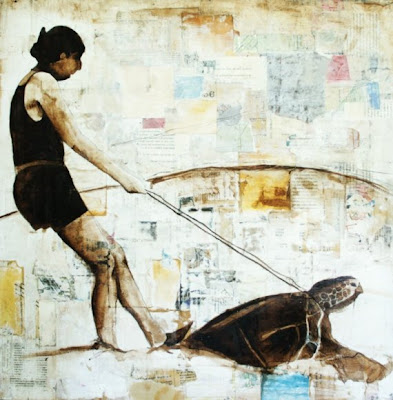Walking the Turtle: The Concept of Speed in Our Modern City
While familiar with the concept of the flâneur, the inquistive wanderer, or "...detached pedestrian observer of a metropolis, a gentleman stroller of city streets". Reading After the City last night, Lars Lerup, in discussing the idea of the 'speed' of the modern metropolis, made a passing reference to a 19th century custom of using a turtle to set the pace for the observer. I was intrigued.
A quote from the nonist (a post that also has some great links) entitled: "Taking the turtle for a walk and letting him set the pace." reinforces this idea in an uncredited quote.
"There was the pedestrian who wedged himself into the crowd, but there was also the flâneur who demanded elbow room… Around 1840 it was briefly fashionable to take turtles for a walk in the arcades. the flâneurs liked to have the turtles set the pace for them."
Another reference on One-Way Street - expands on this in the post on f 'A Turtle on a Leash':
"The second development in urbanism leading to the rise of flâneurie was the construction of the Paris arcades in the early nineteenth century. The arcades offered a respite from the bustling crowd outside. Dandies began to frequent the fashionable arcades, taking in the sights and offering themselves up as spectacles in their own right. Around 1839, Benjamin reports, it was fashionable to walk through the arcades with a turtle on a leash in order to enforce the slow pace really determined looking required."
The concept of speed in our modern city makes one appreciate the idea of a pace-car to offset the rapidity of our contemporary life. This includes the physical (high speed rail, bus rapid transit, more horsepower, higher speed limits), as well as the virtual (rapid access to information via rss, web, smart phones, wi-fi) make just sitting (or strolling) and observing somewhat of a novelty.
A recent exercise in a class on research methods reinforced that for me - by sitting in a space (namely a local plaza here in Portland) for three separate occasions to merely 'observe' and take notes was jarring in its simplicity. I wasn't counting or doing anything qualitative, merely going for a rich description of activity and use of space. The experience made me think of what we miss in our fast-paced lifestyle in car windows, or even on bike or just walking 'to get somewhere'. Opening oneself up to observation at a slow(er) speed is invigorating and the polarity of our We stare at computers, magazines, books, or other media, but when the subject is the city (urbanism), it is easy to forget this isn't a detached idea, hypothesis, or theory - but something right outside your door.
Grab the turtle... its time for a walk.

